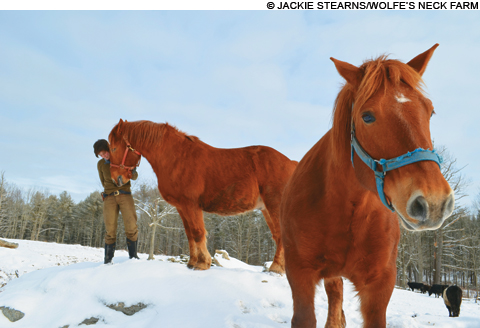
ADDITIONS Powerful horses Harley and Sam are new to the Wolfe’s Neck
animal barn. |
When we think of farms, fruits and vegetables, and the bounty of the garden, we don't usually think of February — at least not in Maine, and definitely not after a blizzard of historic proportions. When we consider the act of farming, we picture a bare-armed afternoon, elbow-deep in dirt, forehead sweaty in the sun. We see turned-over earth, insects, and vibrant colors: greens, reds, oranges . . .
In fact, it's easy to think of working farms as hibernating entities not much different from bears, garter snakes, or hedgehogs.
But even against February's gray-white backdrop, a farmer's labor continues. "To live and work on a farm is really to be in a cycle," says Seth Kroeck of Crystal Spring Community Farm in Brunswick, which sells organic produce and Katahdin pasture-fed lamb.
While this farm manager admits that winter hours are much less demanding (20 to 40 per week as opposed to 80 to 100 at the peak of growing season), there's still a lot going on this time of year. Seed orders were placed at the beginning of the year, and the 2012 financial books were balanced and closed. The hay baler and tractor need maintenance. Firewood needs to be chopped. Soon, Kroeck will start interviewing and hiring apprentices (he typically manages anywhere from four to eight additional employees from late spring to early fall). And in a couple weeks, "we'll start getting the greenhouse ready to start seeding for the summer," he says.
The cold months provide time for planning, too. "In general, winter is the prime time of year that we step back and plan for the spring-summer-fall seasons," says Dave Herring, executive director of Wolfe's Neck Farm Foundation in Freeport. " And in this arena, some farmers choose to go high-tech.
"We spend a great deal of time on record keeping and re-vamping field plans for the upcoming season," says Stacy Brenner of Broadturn Farm in Scarborough. "We are huge of fans of Google and keep all our field maps and records on Google Earth. We use a plethora of spreadsheets to plan seeding and transplanting dates, succession planting schedules for fields and hoop houses, seed orders, targeted harvest dates and yields, and we update all of these with notes we take throughout the season." (Backyard growers, you can do this too, even in a regular old spiral-bound notebook!)
Broadturn is also taking this down time to hash out the logistics and location of its new retail shop in Portland, which is slated to open this spring. With help from a Farms for the Future grant from the state Department of Agriculture, Brenner and her husband, John Bliss, are launching an urban farm store — "sort of a version of our current dooryard farmstand, Flora*Bliss, but in the city," she says.
Many farms take the December-to-March lull to ramp up other programming. Wolfe's Neck, for example, offers winter vacation day camps for kids, and in February and March they will run a four-day course that will teach "comprehensive skills in sustainable woodlot management with a draft horse" ($450; visit wolfesneckfarm.org for details). Want to meet these powerful horses, but not necessarily for logging purposes? Bundle up and stop by the farm this Saturday between 10:30 am and 12:30 pm for an all-ages Draft Horse Meet and Greet.
And of course, the cold months pass before we know it.
"Believe it or not, our first seeding date is the last week in February," Brenner says. "Once we start seeds, the woodstove for the greenhouse needs to be fired daily and the plants all need tending. The pace really picks up quickly."
The (non)hibernation ends, and the growing cycle begins again.